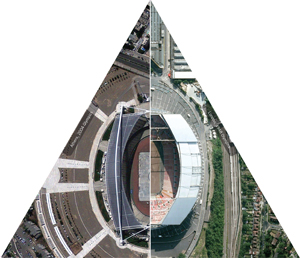Press Release: Carnegie Mellon's Miller Gallery Opens New Section of Pittsburgh Biennial
Exhibit Features Installations by International Artists Working Collaboratively
Contact: Teresa Thomas / 412-268-2900 / thomas@cmu.edu PITTSBURGH—The Miller Gallery at Carnegie Mellon University opens a new section of the 2011 Pittsburgh Biennial, Sept. 17 - Dec. 11, featuring five new installations, including sculpture, printmaking, painting, video, publications and workshops. An opening reception will be held from 6 to 8 p.m., Friday, Sept. 16 at the Miller Gallery, preceded by a tour of the exhibition with the curator and artists.
PITTSBURGH—The Miller Gallery at Carnegie Mellon University opens a new section of the 2011 Pittsburgh Biennial, Sept. 17 - Dec. 11, featuring five new installations, including sculpture, printmaking, painting, video, publications and workshops. An opening reception will be held from 6 to 8 p.m., Friday, Sept. 16 at the Miller Gallery, preceded by a tour of the exhibition with the curator and artists.
“The collectives and collaborators exhibited here encourage us to reassess our assumptions and values, reveal the global in the local and the personal in the political, and imagine alternate realities and possible futures,” said Miller Gallery Director Astria Suparak, who is curating the exhibit.
Suparak said the collaborative approach taken by the artists echoes the long labor and union histories of the Pittsburgh area, as well as the Biennial’s new partnership among local art organizations. The multigenerational selection of artists, who currently live in Pittsburgh or spent significant time here, also exhibit internationally, reflecting the connection Pittsburgh has to the global art world.
“The projects demonstrate the strength of collective voices in deciding the future of neighborhoods, cities, nations, and societies, and the importance of intimate conversations and compassionate listening,” Suparak said.
Setting a new precedent for city-wide collaboration among major art institutions, the Pittsburgh Biennial is co-organized by the Carnegie Museum of Art, the Miller Gallery at CMU, The Andy Warhol Museum, and Biennial founders Pittsburgh Filmmakers and the Pittsburgh Center for the Arts. Each of the five partner institutions will present a distinct exhibition of work by artists connected to the Pittsburgh region, reflecting each organization’s curatorial focus.
Works in the exhibition include:
 “Global Cities, Model Worlds,” an installation by Sarah Ross and Ryan Griffis of Chicago and Carnegie Mellon alumna Lize Mogel of New York, explores the spatial and social impacts of “mega events,” such as the Olympics and World’s Fairs. The host cities of these international spectacles seek to transform themselves into “global cities” through planning, architecture and ideology. Locally, these events pave the way for redevelopment projects that can create new public resources, such as parks, stadiums or transportation infrastructure, but often result in significant displacement of residents or industry, reinforcing existing inequalities. “Global Cities” contrasts the promise of transformation with the on-the-ground realities of urban development.
“Global Cities, Model Worlds,” an installation by Sarah Ross and Ryan Griffis of Chicago and Carnegie Mellon alumna Lize Mogel of New York, explores the spatial and social impacts of “mega events,” such as the Olympics and World’s Fairs. The host cities of these international spectacles seek to transform themselves into “global cities” through planning, architecture and ideology. Locally, these events pave the way for redevelopment projects that can create new public resources, such as parks, stadiums or transportation infrastructure, but often result in significant displacement of residents or industry, reinforcing existing inequalities. “Global Cities” contrasts the promise of transformation with the on-the-ground realities of urban development.- Transformazium, comprised of Ruthie Stringer, Dana Bishop-Root, Leslie Stem and Caledonia Curry, create an evolving installation with bricks from a condemned building they deconstructed near their home in North Braddock, a suburb of Pittsburgh. During the course of the exhibition, collective members and gallery visitors will clean the bricks, visibly transforming waste to useable resources and underlining the economic viability and environmental sustainability of deconstruction, or “green demolition.” In neighborhoods that face high levels of property abandonment as well as persistent under-employment, deconstruction “makes room for the possibility to discover wealth in places of blight and energy in places of stagnation.”
- Justseeds is a worker-owned cooperative of printmakers in the U.S., Canada and Mexico, with several members in Pittsburgh. For the Biennial they built a landscape overpopulated by billboards. The artists simultaneously subvert the hard-to-ignore, omnipresent advertising medium and playfully concede their didactic tendencies; instead of peddling products, the handmade billboards advocate for borderless nations, indigenous sovereignty, immigrant rights and compassion. Justseeds believes in “the transformative power of personal expression in concert with collective action.”
- subRosa, a collective whose core members are Hyla Willis of Pittsburgh and Faith Wilding of Providence, R.I., speculate on how feminism could affect the scientific world, as it has with art and other areas of culture. In their installation “Feminist Matter(s): Propositions and Undoings,” they invoke cultural producers, experimenters and processes that could be antecedents of this new way of thinking and working. Inspired by modernist writer Virginia Woolf’s antidote to the war-mentality brewed in boardrooms and command centers, subRosa re-envisions lab workbenches as a series of small tables for more intimate and conversational “tea-table thinking.”
- Temporary Services, comprised of CMU alumnus Marc Fischer of Chicago, Salem Collo-Julin of Philadelphia, and Brett Bloom of Copenhagen, present two projects. One is “Self-Reliance Library,” a collection of recently published and out-of-print books and reference materials that the artists have found inspiring and hope will “provoke the reader, solve creative problems, or suggest imaginative directions for a range of creative practices.” Topics represented in the library include visionary architecture, nomadic living, self-publishing, everyday repair solutions, designs for alternate realities, survivalism and skill sharing.
Admission to the Miller Gallery is free and open to the public. Hours are noon – 6 p.m., Tuesday – Sunday. For more information including print-ready images and downloads, visit http://www.cmu.edu/millergallery/exhibitions/pittsburghbiennial2011
###
Pictured above are America (top image), from Justseeds installation, Josh MacPhee, 2011; and Olympic Stadiums: Athens 2004/London 1948, from Global Cities, Model Worlds installation, L. Mogel, S. Ross, R. Griffis, 2011